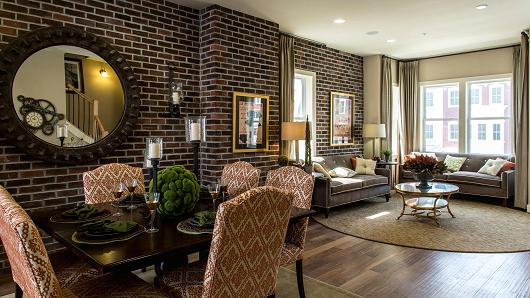
Everyone is his or her own Martha Stewart, and who wouldn’t want to see beautiful pictures of our loved ones on the mantel? Answer: potential buyers. They don’t want to see your babies, your knickknacks, your artwork or even those adorable macramé potholders you and your daughter made that rainy afternoon a decade ago.
Savvy real estate agents will tell sellers to clean up, clean out and put away most personal items. The idea is that house hunters should be able to picture themselves — and not you — in your house. Odd artwork, even though it’s not staying, is off-putting.
That is why, in a market where picky buyers want move-in ready real estate, staging is becoming more and more the rule.
Staged homes spend half as much time on the market than non-staged homes, according to Coldwell Banker Real Estate.. What’s more, those staged homes on average sell for more than 6 percent above asking price.
The seller “gets probably 10 times what they put into it,” according to Mary Lynn White, a real estate agent with Evers & Co. in the Washington, D.C., area. “I call it aspirational selling,” she added. “Buyers think they’re going to live the way the house is set up.”
“When I put a house on the market, it’s going to look nice,” she said. “It benefits me and the seller.
“They refer me to other people,” White added. “It’s an investment I make in my business.”
The investment, she said, can run anywhere from $1,000 to $5,000, depending on the size of the home and whether or not it needs furniture to be replaced. Renovation websites list the cost of staging from as low as $500 to as high as $6,000. It can include rental furniture and rugs, paint, window treatments and props. It does not include major home repairs.
“I feel like I make a nice sum of money when I sell houses, and I don’t want a house unless it’s staged.”
The staging is actually more for the pictures than for the people walking through the home. That is because the vast majority of buyers search online and scan the interiors of homes they want to visit. A good set of pictures will draw more buyers, and those pictures should show pretty and pristine spaces.
Homeowner Andrew Heighington and his wife Kate needed to quickly sell their house in Northwest Washington, D.C. A new job put Andrew up in New York almost immediately, and with a toddler daughter and another baby on the way, they didn’t have time to waste. They hired White, who spent $3,000 of her own to stage their home, which was originally listed at $899,000.
“Staging elevated each room in our home and transformed our house to appeal to the discerning homebuyer,” Heighington said. “Although living in a staged house may not be as comfortable, it was well worth it.”
He said that decluttering to prepare for the staging, especially with a young child, was the biggest challenge. Also, certain household items the family used regularly had to be packed up and weren’t as accessible with a staged home.
“I feel like I make a nice sum of money when I sell houses, and I don’t want a house unless it’s staged,” White said. She used professional stager Garnet Hadley to do the work on the Heighington residence. Hadley has staged homes large and small, occupied and empty, and she can spend up to three days doing the transformation.
The biggest problem with a house someone is living in is whether they understand the philosophy of staging, Hadley explained. “You have to be very diplomatic and work around that,” she said.
With staging, the idea is to make small rooms seem larger and help buyers envision what types of furniture can be put where. The stager needs to identify the function of the room and convey it.
For example, an eat-in kitchen should have a table in it, and a small bedroom that may look too small for a bed should have a bed in it. People can’t always visualize the size of furniture.
“I try to be the bad guy, the fall guy for the Realtor,” said Hadley, who always explains her staging philosophy to the seller before starting. “It’s about selling your home to the perspective buyer and who is going to be your buyer.
“If it’s a younger couple with children, we have to appeal to them with the type of furnishings they might envision.”
That might mean taking precious antiques out of an older owner’s home, no matter how valuable they are. It also means depersonalizing the home, to a point. The home should look like a real person lives there.Hadley has gone so far as to organize closets and kitchen cabinets, just so there is nothing in the house that might dissuade a potential buyer.
Not all rooms have to be staged, especially if the seller isn’t living there. They can be left empty and clean.
While there are no formal rules for what should and shouldn’t get a makeover, first impressions count. That means the front porch or stoop are equally as important as the entry hall and front room. After all, they set the stage for any sale.
[Source:- CNN]




